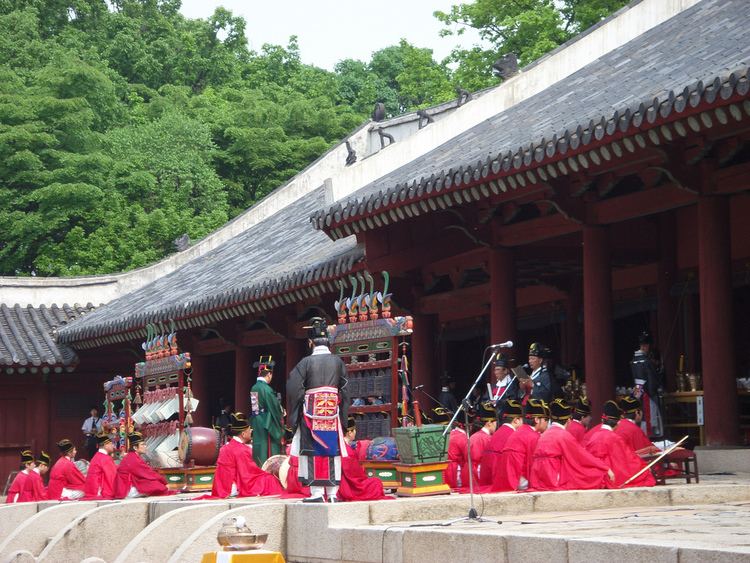Hangul 종묘제례 or 종묘대제 | Hanja 宗廟祭禮 or 宗廟大祭 | |
 | ||
Revised Romanization Jongmyo jerye or Jongmyo daeje McCune–Reischauer Chongmyo cherye or Chongmyo taeche | ||
Jongmyo Jerye or Jongmyo Daeje is a rite held for worshipping the late kings and queens of the Joseon Dynasty in Jongmyo Shrine, Seoul, South Korea. It is held every year on the first Sunday of May. The Jongmyo rite is usually accompanied with the court music playing (Jerye-ak) and dance called Ilmu or line Dance. Jongmyo Jerye and Jeryeak were designated as the first of South Korea's Masterpieces of the Oral and Intangible Heritage of Humanity by UNESCO in 2001.
Contents
History
The Jongmyo rites originated from Ancient China. These rituals were seen as essential to the preservation and continued prosperity of the state and so each dynasty in China and Korea placed a great deal of importance in them which can be seen from Confucian texts and the very mention of 'preserving the Sacred Shrines' whenever there was talk about the state being in peril. The ceremonies reinforce the Confucian link between ancestors and their descendants, parent and child, essentially the family; the act of communing with them is a prayer and invocation for the ancestors for the preservation and good health of the state.
They were practised in Korea for the first time in Silla era and preserved from the Goryeo Dynasty to the last Korean Dynasty of Joseon. Along with the ceremony for praying to the Gods of Earth for bountiful crops, it is considered Korea's highest-ranked rites. These practices have been lost in China due to the abolition of the monarchy but Korea still preserved it well after their own monarchy was abolished.
The current ceremonies are organised and performed by the descendants of the former royal family, the Korean Imperial Household, with assistance from other cultural organisations. The King's role is played by a senior member of the Household, usually the Hereditary Prince Imperial of Korea, who technically would have performed the same rites if Korea was at present a monarchy (the former kings being his actual ancestors).
Procedures
The Jerye procedures were divided into three parts. It is regarded as Korea's highest-ranked ritual, so it was held strictly and solemnly. The first part is the procedures to invite and greet the spirits. Most of the rites are held by king, officiants and his family. The first part's procedures are jagye (purification). Chwiwi is the part when the king and choheongwan (people who bring the wine for offering rituals) take the position into the chamber of the shrine. Then they wash their hands for greeting the spirits (gwansewi). In the Cheonghaengrye and Singwanrye rituals, they begin the rite of greeting the gods of Heaven and Earth by offering wine.
The second is rituals for entertaining the spirits. It is started the rites of Jinchan, which serves 63 kinds of foods to the spirits. Then the king begin to serve the first wine offering to the ancestral rites (Choheonrye) followed by Aheongwan (Crown Prince) and Jongheongwan (Prime Minister). This ritual is followed by rite of reciting the prayer paper by people called Daechukgwan. Aheonrye and Jongheonrye are the rites of the second and third (last) of wine offering.
The third part is the last rites which are held to send off the spirits to heaven. Eumbok is an occasion of sharing foods and wine to the officiants. The Cheonbyeondu is the rite of removing all the foods served for the spirits. In Songsin, the Choheongwan and other officiants bows four times to send off the spirits to heaven. Mangryorye is the last rite held by burning the prayer papers and the king is reported by the Heongwan and Daechukgwan that the rituals and services are completed and all the officiants withdraw.
Jerye-ak
During the rituals of Jerye, it were held together with the court music playing (Jerye-ak) to bring an enjoyment for the spirits invited into the rites. Jerye-ak compositions played in the rites were Botaepyeong and Jeongdaeeop. There were also songs that accompanied the jerye-ak, named Jongmyo Akjang.
An elaborate performance of ancient court music (with accompanying dance) known as Jongmyo jeryeak (hangul: 종묘제례악; hanja: 宗廟祭禮樂) is performed there each year. Musicians, dancers, and scholars would perform Confucian rituals, such as the Jongmyo Daeje (Royal Shrine Ritual) in the courtyard five times a year. [1]. Today the rituals have been reconstructed and revived. The Jongmyo Daeje has been designated as Important Intangible Cultural Property No. 56 and is performed every year in May. [2]. The Jongmyo Jerye-ak, the traditional court music of Joseon, is performed by the Royal Court Orchestra and has been designated as Important Intangible Cultural Property No. 1.[3]. This court music has its origins in Chinese court music that was brought to Korea during the Goryeo period. [4]. King Sejong composed new music for the ritual based largely on hyangak (with some dangak) in 1447 and 1462. [5].
Dances
The Jerye's dance is called Ilmu (line dance). Ilmu divided into Botaepyeong-ji-mu (dance to praise achievements of the former kings), and Jeongdaeeop-ji-mu, (dance to praise the king's military achievements). Ilmu dances are performed by a group of 64 women dancers wearing purpled-clothing dance. They called Palilmu because they dance in 8 lines and rows.
Ilmu divided into two types of dance, Munmu and Mumu. Munmu is accompanied by Botaepyeong-ji-ak, with Yak (a three-holed bamboo flute) in the left hand and Jeok (a pheasant-feather tasseled wooden bar) in the right hand. Mumu is a military dance. The dancers move fastly by holding wooden swords and the rear four rows wooden spears in the front four rows .
